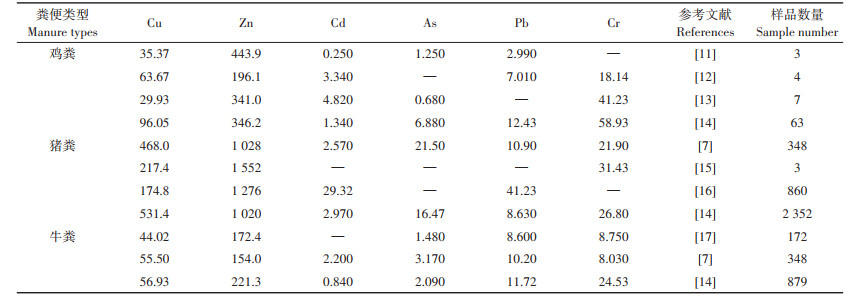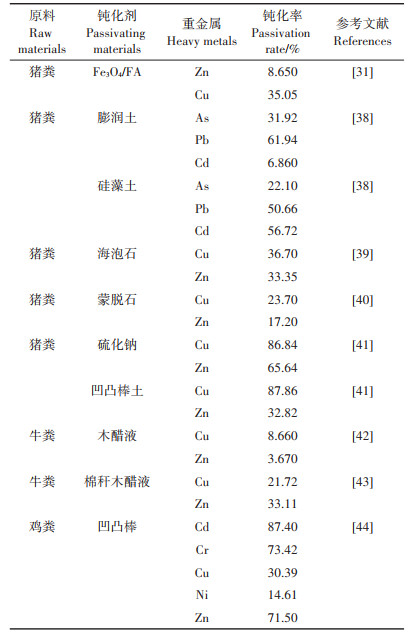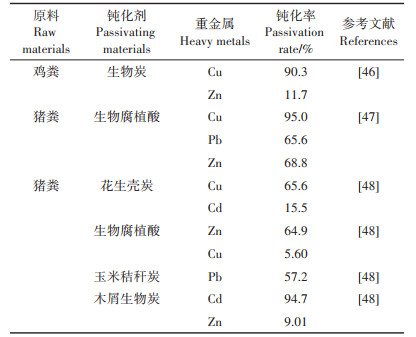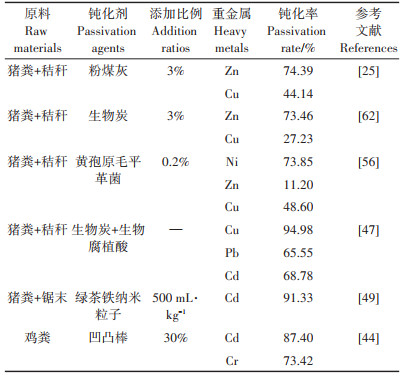改革开放以来,我国养殖业规模不断壮大,产生了大量废弃物[1],每年粪肥资源量已达3.8×109 t[2]。集约化养殖场的粪肥和废水除了含有大量的养分资源,还可能带有重金属和抗生素等污染物,因土地消纳面积有限,高粪肥负荷还田可能会带来严重的环境风险[3],因此,好氧堆肥肥料化利用或厌氧发酵的能源化利用是普遍的养殖废物处理方式。
我国粪肥中主要存在8种重金属(Cd、Pb、Cr、As、Hg、Cu、Zn、Ni),其中,Cu、Zn、As和Cd的含量相对较高。调查发现,粪肥已成为我国7种主要农田土壤重金属的第二大来源[4],长期施用高量粪肥(m鸡粪∶m牛粪= 3∶1)会显著增加农田土壤Cd、Zn、Cr和Cu的总量[5]。穆虹宇等[6]采集和检测了吉林、青海、河北和江苏等21个地区总计348个粪肥样品,结果显示Cu和Zn超标率约50%,而Cd、As超标也超过10%。粪肥的施用会增加蔬菜、粮食作物和部分经济作物中重金属的潜在风险,通过食物链的生物富集对人类身体健康产生威胁[7-8]。
粪肥中重金属活性较高,为畜禽粪便的安全利用带来不容小觑的污染风险[5]。好氧堆肥过程对物料中的重金属有一定的影响,但一般认为随着堆肥的进行,物料损失产生的浓缩效应会显著增加堆肥中重金属的含量[9]。很多研究者认为,堆肥化处理只是浓缩了粪肥中的重金属,无法将其移除,因此对于粪肥的重金属减量化没有作用。将含重金属的堆肥产品施入到土壤后其中的重金属也可能被重新活化从而被作物吸收。最近的一些研究发现,在堆肥过程中添加钝化材料对土壤重金属有显著钝化效果,并且此类钝化剂对改良土壤理化性状也有积极作用[10]。但目前研究涉及的钝化材料来源广泛,钝化机理各有不同,且钝化堆肥施用于土壤后的迁移转化过程仍不明晰。因此,本文围绕粪肥中重金属含量及其在堆肥过程中的形态变化,总结了目前已探明的堆肥中重金属固定机制,并列举分析了现阶段在堆肥中使用效果良好的重金属钝化剂,旨在促进堆肥中重金属钝化材料的深入研究和有机肥的安全生产。
1 粪肥中重金属的赋存特征集约化养殖过程中,饲料加工厂通常在饲料中加入一定剂量的Cu和Zn来提高饲喂收益和饲料转化率,As添加剂对于动物的生长能够起到一些积极作用,可以改善动物的毛色并促进生长,这些添加剂是粪肥中重金属的主要来源。通过对全国粪肥样品调研测试的文献搜集汇总(表 1)发现,粪肥中Cd、As、Cu和Zn 4种重金属元素超标率较高,Cu和Zn超标率约50%(采用德国腐熟标准计算),而Cd、As超标率也超过10%[18]。尤其是猪粪,其Cd、As、Cu和Zn元素的含量显著高于牛、羊和家禽粪便,猪粪中4种重金属的平均含量是其他3种粪便的1.0~3.0、1.8~6.8、4.9~17倍和2.7~12倍,其中Cu和Zn含量中位值分别高达396 mg·kg-1和721 mg·kg-1。反刍动物(牛和羊)粪便中各类重金属含量均相对较低,而鸡粪中Pb和Cr的含量较高[7]。
|
|
表 1 畜禽粪便中重金属含量(mg·kg-1) Table 1 Concentrations of heavy metal in different kinds of manure(mg·kg-1) |
重金属生物有效性指在一定的生理条件下,活化的重金属进入人体和动物血液系统或者微生物和植物体的那部分[19],而粪肥中重金属的形态与其被施入到土壤后的生物有效性有很大关系。一般地,将重金属的形态按BCR连续提取方法分为可交换态、可还原态、可氧化态和残渣态4种[20],从重金属在环境中的毒性、活性以及生物有效性来看,可交换态、可还原态与可氧化态的环境风险依次降低,而残渣态的迁移性很小,也很难被生物利用[21]。研究表明粪肥中Cu、Zn和Cr以残渣态含量居多,均超过总量的50%;Cd以可还原态和残渣态为主[15, 22]。
2 堆肥化处理对粪肥重金属含量和形态的影响 2.1 重金属含量粪肥中的重金属元素很难以气体的形式挥发排出,堆肥进行时微生物分解作用和高温会促使堆体中包含N、C、H、O等元素的有机化合物降解,以气体的形式挥发,使得堆体的含水率降低,体积变小,而重金属元素却仍然富集在原料中,从而相对增加了其含量(表 2)。粪肥中含量相对较多的Cu和Zn重金属,其相对浓缩效应尤为显著。例如尹晓明等[27]以猪粪和砻糠为原料进行好氧堆肥,堆肥结束时Cu、Zn和Mn的含量分别比堆肥开始时增加了9.20%、17.46% 和35.62%。当粪肥与重金属含量较多的原料共堆肥时这种浓缩效应会更加明显,例如吴飞龙等[28]以猪粪渗滤液和污泥进行共堆肥,结果显示,与猪粪污泥混合原料相比,重金属Cu、Zn、Cd和Pb的含量在堆肥结束时分别提高了13.8%、20.4%、19.1%和3.73%。
|
|
表 2 各种堆肥中重金属总量富集情况 Table 2 Increment rates of heavy metal concentration after composting |
粪肥经过堆肥处理之后,除了As等重金属高活性形态含量变化较小外,绝大部分重金属表现出由有效性较高的形态向有效性较低的形态转变,这说明堆肥工艺对粪肥中重金属活性的降低有促进作用[5, 8, 29]。好氧堆肥处理对猪粪中含量较多的Cu和Zn形态转化有显著的效果,王义祥等[30]的研究表明,在对猪粪菌渣进行堆肥化处理后,粪肥中Cu和Zn的可交换态含量有所降低。LI等[23]发现在猪粪好氧堆肥处理后Cu的钝化率达到70.36%,包括空白组在内的所有处理的残渣态含量都有提升,可交换态含量降低效果最佳,减少了145.41 mg·kg-1。吴迪梅等[25]的研究发现堆肥处理能降低猪粪中重金属Zn的生物有效性。
3 添加钝化剂对堆肥处理粪肥中重金属活性的影响 3.1 无机钝化剂粉煤灰、钙基膨润土、磷酸盐岩、石灰或沸石等无机钝化剂最为显著的特点是具有良好孔隙结构和较大的比表面积。由于它们具有较大的静电力和离子交换性能,这些无机钝化剂可以对重金属进行有效吸附[31],从而降低其生物有效性[32]。LIU等[33]合成了磁性粉煤灰复合材料(Fe3O4/FA,以磁铁矿和粉煤灰为原料烧制而成的材料)并以不同比例与猪粪混合,结果表明,Fe3O4/FA的添加使Cu和Zn的残渣态含量分别升高了35.05% 和8.65%。王权[34]将麦饭石添加到猪粪堆肥中,它不仅以自身良好的吸附性降低了Cu、Zn的活性,而且可调节堆体胡敏素含量,间接对Cu、Zn产生钝化效果。无机钝化剂对重金属的钝化机制主要包括吸附作用、生成沉淀、与重金属进行离子交换,以及通过刺激微生物活性与促进腐殖质形成间接提高重金属的稳定性等(图 1)[34-35]。无机钝化剂较易获得、原理简单、操作简便,但钝化剂与重金属的结合以物理吸附为主,而且部分钝化剂与重金属之间的结合并不十分紧密,要保持长期的钝化效果较为困难[36]。WANG等[37]在堆肥中添加生物炭+沸石的组合,结果显示堆体中富里酸复合Cu和富里酸复合Zn有所减少,转化为腐植酸复合Cu和腐植酸复合Zn,从而进一步提高了重金属的稳定性。因此,添加到堆肥中的无机钝化剂可以固定各种有机废物中的重金属(表 3,其中钝化率指堆肥前后重金属有效态含量之差与堆肥前重金属有效态含量的比值,以百分数表示,其中有效态含量为可交换态与可还原态含量的总和),从而相应地降低堆肥产品应用于土壤的风险。
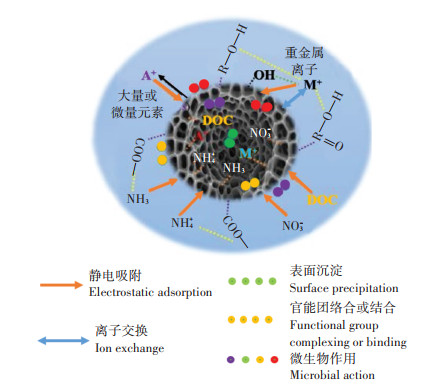
|
图 1 无机钝化剂对重金属钝化的机制[34-35] Figure 1 Mechanism for passivation of heavy metals by inorganic passivation agents[34-35] |
|
|
表 3 无机钝化剂对堆肥中重金属的钝化效果 Table 3 Passivation effects of inorganic passivating materials on heavy metals during composting |
有机钝化剂主要包括秸秆生物炭、竹炭和木本泥炭等碱性物质含量较高且含有机物较多的钝化材料,有机钝化剂本身富含有机质和其他一些植物所需元素,可以提升有机肥的养分[45],并且其对粪肥中的重金属具有不同程度的钝化效果(表 4)。HAO等[46]在鸡粪堆肥中添加10%(质量分数)生物炭,结果表明,生物炭显著降低了Cu和Zn的生物利用率,与堆肥前比,有效态降低率分别为90.3%和11.7%,显著高于对照组。ZHOU等[47]在猪粪堆肥中添加生物腐植酸,Cu、Pb和Zn的钝化率最大分别为94.98%、65.55%和68.78%。YANG等[49]合成了一种以绿茶提取物负载铁纳米离子的有机材料(G-nFe),并将其添加到猪粪高温好氧堆肥中,结果表明,堆肥15 d内各处理中Cd均发生了明显的钝化,其中一组的残留态Cd从0.001 6% 增加到55.70%,可交换态Cd从98.54% 减少到7.21%,显著高于对照组。同时,部分有机材料会改善细菌群落结构、增强细菌与重金属组分之间的相关性[50]。因此,炭基材料等有机钝化剂不仅可以直接络合重金属,而且可以通过影响堆体中微生物群落间接降低重金属有效态。
|
|
表 4 有机钝化剂对堆肥中重金属的钝化效果 Table 4 Passivation effects of organic passivating materials on heavy metals during composting |
以钝化重金属常用的生物炭为例,在堆肥中生物炭上重金属被固定或活性降低的机制多种多样,吸附、络合、沉淀和还原等作用均可影响重金属的迁移率和生物有效性[51]。通常认为,沉淀是生物炭去除重金属的重要机制[52]。钝化剂中的矿物元素可能与重金属沉淀,形成难溶性沉淀物。与其他元素相比,具有中等电离势(2.5~9.5)的贵金属,如Zn、Cu、Ni和Pb,会在化学钝化剂上产生更多的沉淀物。在生物炭表面发生的重金属吸附中,离子交换机制的作用和生物炭的表面形态有关[52]。离子交换的具体过程是将生物炭表面带正电的物质替换为环境中的重金属阳离子,达到重金属离子的去除效果。例如QIAN等[53]的研究表明,随着温度升高(100~400 ℃),生物炭胶体去除Cr(Ⅲ)的作用显著增强,这主要是离子交换机制在主导。
具体而言,首先重金属可与生物炭的矿物氧化物进行共沉淀发生内球络合,或者与生物炭表面的官能团和矿物氧化物的游离羟基进行表面内球络合。这种类型的吸附对于包含部分填充的d轨道的过渡金属非常重要,因此对配体具有很强的吸引力。LIU等[54]的研究表明在相对较低的温度下生产的生物炭中,富氧表面官能团(例如羟基、羧基和酚基)可以成功吸附受污染水环境中的重金属。炭基材料中富氧官能团的浓度会随着时间的推移而增加,这可能归因于在炭基材料表面的氧化过程中产生了更多羧基[55],从而增强了配体与金属的相互作用。
3.3 生物钝化剂生物钝化剂主要是通过微生物吸附等作用促进重金属钝化。接种菌剂可以大幅降低堆体中重金属有效态含量,例如刘艳婷等[56]在猪粪好氧堆肥中添加黄孢原毛平革菌(Phanerochaete chrysosporium),结果显示Zn和Cu的钝化率分别达59.4% 和69.7%。YANG等[8]从土壤中筛选出一种能钝化重金属的芽孢杆菌,负载在海绵和棉花上加入到污染土壤和玉米粉堆肥中,对Cr的吸附率分别达到19.09%和26.36%。
微生物可以从不同受污染介质中吸附重金属,并通过还原作用、淋溶作用、吸附作用、生物矿化等途径钝化重金属。微生物主导的以生物修复为核心的堆肥处理的优势在于,对重金属有钝化效果的假单胞菌、芽孢杆菌和链霉菌等细菌是发酵行业的常用菌种,易于获得,可以满足大规模修复的需要[57]。一些细菌菌株由于具有较高的金属亲和力,被广泛用于废水和土壤中去除重金属[8, 58]。其具体机理为重金属离子靠近细菌表面时与其上的磺酸盐、羟基、羧基和酰胺等官能团进行化学络合,由于革兰氏阳性菌细胞壁较厚,由肽聚糖、回声酸和破伤风酸组成,一般来说其对重金属的专性吸附效应强于革兰氏阴性菌[59]。此外,真菌对重金属也具有良好吸附性能,并且容易获得。重金属污染环境中真菌钝化重金属的机制包括主动吸附、胞内和胞外沉淀等[60]。而与堆肥技术的结合可以保护微生物免受重金属的直接侵害,并增强微生物的活性,从而增强微生物的修复能力[61]。在堆肥中使用生物菌剂作为重金属钝化剂时,由于添加的菌剂与堆体中微生物群落具有融合性,最终的有机肥产品大多都是无害化的,不会产生二次污染,且施用于土壤后不会破坏相关植物的生长环境。在培养出耐重金属的细菌后,此类钝化剂便较易获取,因此生物钝化剂亦是今后堆肥中重金属钝化剂的理想研究方向。
目前,在堆肥中对重金属钝化效果较好的钝化剂主要以有机钝化剂或有机与无机复合钝化剂为主(表 5),它们对粪肥中一些主要重金属(Cu、Zn)的钝化率超过60%,可以有效降低弱酸提取态等生物有效性较强的重金属形态含量,并且促进重金属的形态向更为稳定的残渣态转化,这其中以生物炭等炭基材料、硫化钠、粉煤灰和黄孢原毛平革菌(Phanerochaete chrysosporium)等为主要代表。同时,超高温堆肥等新型工艺也被应用在粪肥堆肥化处理过程中以实现重金属的固定,例如刘晓明等[63]的研究认为超高温堆肥能够在堆体内快速形成腐植酸和富里酸,并通过腐植酸与重金属离子络合反应实现对重金属的钝化。
|
|
表 5 几种效果良好的典型堆肥重金属钝化材料 Table 5 Several typical passivation materials on heavy metals during composting |
有机肥最终被投入农田,其中的重金属通过添加剂或者其他工艺被有效固定时,土壤的理化性质(pH值、有机质、离子交换能力、土壤类型和土壤质地等)变化对重金属的总量和生物有效性会有相应的影响[64],其中土壤中含量较多的重金属(如Cu等)生物有效性和溶解度主要受土壤pH值的影响较大,其次是土壤有机质和腐植酸含量[65]。
土壤pH值对金属的溶解度和迁移率具有很强的影响[66-67],堆肥的添加可以提升土壤pH,从而增强对部分重金属的钝化作用[68]。部分研究中堆肥不仅固定自身的重金属,而且对土壤中重金属产生钝化效果,这可能是由于堆肥使得土壤表面负电荷增加[69]。例如ZHOU等[47]利用生物腐植酸和生物炭作为猪粪堆肥的重金属钝化剂,在堆肥结束后继续降低了以酸性土壤为原料的盆栽试验油菜中Cu、Pb和Cd的含量,钝化效果良好。LIU等[70]通过陈化堆肥的处理使Cu、Zn和Ni的有效态达到较低水平,在保持自身较低重金属有效态的同时对酸性土壤(pH=4.12±0.2)中的重金属起到固定作用。大多数重金属的钝化有赖于碱性环境的支持,大部分钝化堆肥的重金属钝化效果在碱性土壤中并未受到显著的影响,而Cd比其他重金属在土壤中更易于被运输到不同的植物组织中[71],而高pH值和有机质含量的土壤环境会降低堆肥中Cd、Ni、Pb和Zn的迁移性,这与以往的研究是一致的[72],而Cu在堆肥和土壤中均具有较低的迁移率和生物有效性。此外,以添加生物炭等有机材料为主的钝化堆肥在施入土壤后,能使重金属保持较好的钝化效果,有机材料对土壤环境酸碱度变化具有一定程度的缓冲作用,当土壤本身pH变化不大时,添加有机钝化剂的有机肥对重金属的钝化作用可逆性不大[73-74]。
堆肥中重金属的变化也与土壤的有机质特性有关。有研究认为有机肥的施用会导致土壤中可溶性有机质的增加,从而间接提升低吸附性土壤(例如砂土)中部分重金属(Cu、Cd)的活性,比如施入粪肥后,土壤中的有机质活化会抵消添加剂对重金属的部分钝化作用[75],例如任凌伟[76]利用鸡粪提取有机质进行重金属吸附试验,溶液中可溶性有机质浓度的增大会导致Cd2+在无机钝化剂表面的吸附量不断降低,膨润土和沸石的最大吸附量分别降低38.4%和57.6%。而一些有机材料(例如生物炭)与土壤有机质含量及赋存形态关联较小,可弱化对重金属活性的间接影响,这进一步表明堆肥中的重金属在土壤中的迁移转化受土壤本身有机质变化的影响较大。
5 总结与展望土壤中重金属难以被完全去除,且客土替代等方法成本高昂、限制因素较多,因此重金属固定化仍然是农田土壤重金属污染的主要解决方案,采用堆肥工艺钝化粪肥中重金属是农田土壤重金属固定化研究的重点,在堆肥过程中添加钝化剂是研究方向,且各种钝化剂的钝化效果已被广泛研究和验证,钝化堆肥还田后不仅可以保持自身钝化效果,而且能达到有效固定土壤中重金属的目的。目前针对部分无机和有机钝化剂在堆体中与重金属间的具体结合作用已经有详细的揭示或阐述,今后在开发新型堆肥钝化剂时应更加注重研究其对重金属的钝化机理,同时关注各种钝化剂的有效使用从而避免二次污染,以及这些钝化剂对堆肥进程的促进效果。
堆肥只能通过改变重金属形态来固定土壤中的重金属,降低植物对其的吸收,但重金属仍保留在土壤中,其形态可能随着土壤环境的改变而变化。因此,如何使钝化堆肥还田后保持自身稳定且兼具钝化土壤原有重金属的效果,仍需进行更加深入的研究。
| [1] |
袁凯, 熊苏雅, 梁静, 等. 畜禽粪便中铜和锌污染现状及风险分析[J]. 农业环境科学学报, 2020, 39(8): 1837-1842. YUAN K, XIONG S Y, LIANG J, et al. Status and risk analysis of copper and zinc pollution in livestock manure[J]. Journal of Agro-Environment Science, 2020, 39(8): 1837-1842. |
| [2] |
农业部办公厅. 重点流域农业面源污染综合治理示范工程建设规划(2016—2020年)[EB/OL]. (2017-04-20)[2020-10-29]. http://www.moa.gov.cn/nybgb/2017/dsiqi/201712/t20171230_6133444.htm. General Office of the Ministry of Agriculture. Construction plan of demonstration project for comprehensive treatment of agricultural non-point source pollution in key river basins(2016—2020)[EB/OL]. (2017-04-20)[2020-10-29]. http://www.moa.gov.cn/nybgb/2017/dsiqi/201712/t20171230_6133444.htm. |
| [3] |
JIA W, QIN W, ZHANG Q, et al. Evaluation of crop residues and manure production and their geographical distribution in China[J]. Journal of Cleaner Production, 2018, 188: 954-965. DOI:10.1016/j.jclepro.2018.03.300 |
| [4] |
PENG H, CHEN Y L, WENG L P, et al. Comparisons of heavy metal input inventory in agricultural soils in north and south China: A review[J]. Science of the Total Environment, 2019, 660: 776-786. DOI:10.1016/j.scitotenv.2019.01.066 |
| [5] |
ZHEN H Y, JIA L, HUANG C D, et al. Long-term effects of intensive application of manure on heavy metal pollution risk in protected-field vegetable production[J]. Environmental Pollution, 2020, 263: 114552. DOI:10.1016/j.envpol.2020.114552 |
| [6] |
穆虹宇, 庄重, 李彦明, 等. 我国畜禽粪便重金属含量特征及土壤累积风险分析[J]. 环境科学, 2020, 41(2): 986-996. MU H Y, ZHUANG Z, LI Y M, et al. Heavy metal contents in animal manure in China and the related soil accumulation risks[J]. Environmental Science, 2020, 41(2): 986-996. |
| [7] |
LANG Q Q, CHEN M J, GUO Y C, et al. Effect of hydrothermal carbonization on heavy metals in swine manure: Speciation, bioavailability and environmental risk[J]. Journal of Environmental Management, 2019, 234: 97-103. |
| [8] |
YANG K J, ZHU L J, ZHAO Y, et al. A novel method for removing heavy metals from composting system: The combination of functional bacteria and adsorbent materials[J]. Bioresource Technology, 2019, 293: 122095. DOI:10.1016/j.biortech.2019.122095 |
| [9] |
HU Y N, CHENG H F, TAO S, et al. China' s ban on phenylarsonic feed additives, a major step toward reducing the human and ecosystem health risk from arsenic[J]. Environmental Science and Technology, 2019, 53(21): 12177-12187. DOI:10.1021/acs.est.9b04296 |
| [10] |
ZHENG G D, WANG X K, CHEN T B, et al. Passivation of lead and cadmium and increase of the nutrient content during sewage sludge composting by phosphate amendments[J]. Environmental Research, 2020, 185: 109431. DOI:10.1016/j.envres.2020.109431 |
| [11] |
邓雯文, 陈姝娟, 何雪萍, 等. 鸡粪-堆肥中重金属残留、抗生素耐药基因及细菌群落变化研究[J]. 农业环境科学学报, 2019, 38(2): 439-450. DENG W W, CHEN S J, HE X P, et al. Dynamics of heavy metal residues, antibiotic resistance genes, and bacterial communities during chicken manure composting[J]. Journal of Agro-Environment Science, 2019, 38(2): 439-450. |
| [12] |
栾润宇. 高温酵素堆肥下鸡粪有机肥重金属钝化与腐殖质含量研究[D]. 哈尔滨: 东北农业大学, 2019: 24-28. LUAN R Y. Study on the inactivation of heavy metals and humus content in chicken manure organic manure under high temperature enzyme composting[D]. Harbin: Northeast Agricultural University, 2019: 24-28. |
| [13] |
栾润宇, 高珊, 徐应明, 等. 不同钝化剂对鸡粪堆肥重金属钝化效果及其腐熟度指标的影响[J]. 环境科学, 2020, 41(1): 469-478. LUAN R Y, GAO S, XU Y M, et al. Effect of different passivating agents on the stabilization of heavy metals in chicken manure compost and its maturity evaluating indexes[J]. Environmental Science, 2020, 41(1): 469-478. |
| [14] |
LIU W R, ZENG D, SHE L, et al. Comparisons of pollution characteristics, emission situations, and mass loads for heavy metals in the manures of different livestock and poultry in China[J]. Science of the Total Environment, 2020, 734: 139023. DOI:10.1016/j.scitotenv.2020.139023 |
| [15] |
谢胜禹, 余广炜, 潘兰佳, 等. 添加生物炭对猪粪好氧堆肥的影响[J]. 农业环境科学学报, 2019, 38(6): 1365-1372. XIE S Y, YU G W, PAN L J, et al. Influence of biochar on the aerobic compost of pig manure[J]. Journal of Agro-Environment Science, 2019, 38(6): 1365-1372. |
| [16] |
王怀中. 饲料和猪粪中重金属含量特征及堆肥耐铅镉菌株的筛选鉴定[D]. 泰安: 山东农业大学, 2019: 34-39. WANG H Z. Characteristics of heavy metal content in feed and pig manure and screening and identification of strains tolerant to lead and cadmium in compost[D]. Tai'an: Shandong Agricultural University, 2019: 34-39. |
| [17] |
贾武霞, 文炯, 许望龙, 等. 我国部分城市畜禽粪便中重金属含量及形态分布[J]. 农业环境科学学报, 2016, 35(4): 764-773. JIA W X, WEN J, XU W L, et al. Content and fractionation of heavy metals in livestock manures in some urban areas of China[J]. Journal of Agro-Environment Science, 2016, 35(4): 764-773. |
| [18] |
YANG X P, LI Q, TANG Z, et al. Heavy metal concentrations and arsenic speciation in animal manure composts in China[J]. Waste Management, 2017, 64: 333-339. DOI:10.1016/j.wasman.2017.03.015 |
| [19] |
马薇, GRAEME I P, 王夏晖. 土壤重金属生物有效性评价方法研究进展[J]. 环境保护科学, 2016, 42(4): 47-51. MA W, GRAEME I P, WANG X H. Research progress on evaluation methods of soil heavy metal bioavailability[J]. Environmental Protection Science, 2016, 42(4): 47-51. |
| [20] |
ÖZBAş B. Removal of heavy metals(Cu, Ni, Zn, Pb, Cd)from compost by molasses hydrolysate[J]. Journal of Environmental Engineering and Landscape Management, 2014, 22(4): 301-310. |
| [21] |
TANG J Y, ZHANG L H, ZHANG J C, et al. Physicochemical features, metal availability and enzyme activity in heavy metal-polluted soil remediated by biochar and compost[J]. Science of the Total Environment, 2020, 701: 134751. DOI:10.1016/j.scitotenv.2019.134751 |
| [22] |
赵恒宇. 堆肥过程中有机物料腐殖化程度对重金属有效性的影响[D]. 北京: 中国农业大学, 2019: 29-31. ZHAO H Y. Effect of the degree of humification of organic materials on the availability of heavy metals during composting[D]. Beijing: China Agricultural University, 2019: 29-31. |
| [23] |
LI F, LI Z A, MAO P, et al. Heavy metal availability, bioaccessibility and leachability in contaminated soil: Effects of pig manure and earthworms[J]. Environmental Science and Pollution Research International, 2019, 26(20): 20030-20039. DOI:10.1007/s11356-018-2080-5 |
| [24] |
AWASTHI M K, DUAN Y, AWASTHI S K, et al. Emerging applications of biochar: Improving pig manure composting and attenuation of heavy metal mobility in mature compost[J]. Journal of Hazardous Materials, 2020, 389: 122116. DOI:10.1016/j.jhazmat.2020.122116 |
| [25] |
吴迪梅, 刁立鹏, 张卓毅, 等. 不同化学钝化剂处理对堆肥重金属(Cu、Zn)形态转化的影响及其植物毒性的分析[J]. 当代畜牧, 2019(10): 40-44. WU D M, DIAO L P, ZHANG Z Y, et al. Effects of different chemical passivators on the transformation of heavy metals(Cu, Zn)in composting and analysis of their phytotoxicity[J]. Contemporary Animal Husbandry, 2019(10): 40-44. |
| [26] |
DENG W W, ZHANG A Y, CHEN S J, et al. Heavy metals, antibiotics and nutrients affect the bacterial community and resistance genes in chicken manure composting and fertilized soil[J]. Journal of Environmental Management, 2020, 257: 109980. DOI:10.1016/j.jenvman.2019.109980 |
| [27] |
尹晓明, 王荣江, 徐潇潇, 等. 猪粪堆肥过程中养分和重金属含量的动态变化[J]. 植物营养与肥料学报, 2019, 25(2): 254-263. YIN X M, WANG R J, XU X X, et al. Dynamic changes of nutrient and heavy metal concentrations during swine composting[J]. Journal of Plant Nutrition and Fertitizer, 2019, 25(2): 254-263. |
| [28] |
吴飞龙, 叶美锋, 吴晓梅, 等. 不同配比猪粪渣/生活污泥堆肥过程养分及重金属含量变化[J]. 福建农业学报, 2019, 34(3): 352-357. WU F L, YE M F, WU X M, et al. Properties of mixed pig manure residue and sewage sludge composts[J]. Fujian Journal of Agricultural Sciences, 2019, 34(3): 352-357. |
| [29] |
SUTHAR S, SINGH S. Feasibility of vermicomposting in biostabilization of sludge from a distillery industry[J]. Science of the Total Environment, 2008, 394: 237-243. DOI:10.1016/j.scitotenv.2008.02.005 |
| [30] |
王义祥, 李波, 叶菁, 等. 生物炭添加对猪粪菌渣堆肥过程中Cu、Zn的钝化作用[J]. 农业环境科学学报, 2019, 38(5): 1176-1184. WANG Y X, LI B, YE J, et al. Passivating effect of biochar on heavy metals(Cu and Zn)during composting of pig manure and mushroom residues[J]. Journal of Agro-Environment Science, 2019, 38(5): 1176-1184. |
| [31] |
YANG Y J, KUMAR A M, DU W, et al. Compost supplementation with nitrogen loss and greenhouse gas emissions during pig manure composting[J]. Bioresource Technology, 2020, 297: 122435. DOI:10.1016/j.biortech.2019.122435 |
| [32] |
SAIM O, SINAN M T, NURTAC O. Simultaneous dry-sorption of heavy metals by porous adsorbents during sludge composting[J]. Environmental Engineering Research, 2020, 25(2): 258-265. |
| [33] |
LIU C R, TONG Q, LI Y C, et al. Biogas production and metal passivation analysis during anaerobic digestion of pig manure: Effects of a magnetic Fe3O4 /FA composite supplement[J]. RSC Advances, 2019, 9: 4488-4498. DOI:10.1039/C8RA09451A |
| [34] |
王权. 添加剂对猪粪好氧堆肥过程的影响及其机制研究[D]. 杨凌: 西北农林科技大学, 2018: 102-109. WANG Q. The effect of additives on the aerobic composting process of pig manure and its mechanism[D]. Yangling: Northwest A & F University, 2018: 102-109. |
| [35] |
WANG Q, WANG Z, AWASTHI M K, et al. Evaluation of medical stone amendment for the reduction of nitrogen loss and bioavailability of heavy metals during pig manure composting[J]. Bioresource Technology, 2016, 220: 297-304. DOI:10.1016/j.biortech.2016.08.081 |
| [36] |
CHEN S B, ZHU Y G, MA Y B, et al. Effect of bone char application on Pb bioavailability in a Pb-contaminated soil[J]. Environmental Pollution, 2006, 139(3): 433-439. DOI:10.1016/j.envpol.2005.06.007 |
| [37] |
WANG H, ZHENG H, JIANG Z, et al. Efficacies of biochar and biochar-based amendment on vegetable yield and nitrogen utilization in four consecutive planting seasons[J]. Science of the Total Environment, 2017, 593/594: 124-133. DOI:10.1016/j.scitotenv.2017.03.096 |
| [38] |
杨坤, 李军营, 杨宇虹, 等. 不同钝化剂对猪粪堆肥中重金属形态转化的影响[J]. 中国土壤与肥料, 2011(6): 43-48. YANG K, LI J Y, YANG Y H, et al. Effect of passivator on form transformation of heavy metal in composting of pig manure[J]. Soil and Fertilizer Sciences in China, 2011(6): 43-48. DOI:10.3969/j.issn.1673-6257.2011.06.008 |
| [39] |
周颖, 罗惠莉, 吴根义, 等. 海泡石基钝化剂对猪粪中铜、锌钝化的影响[J]. 环境污染与防治, 2019, 41(1): 55-59. ZHOU Y, LUO H L, WU G Y, et al. Effects of sepiolite based passivator on the stabilization of Cu and Zn in pig manure[J]. Environmental Pollution and Control, 2019, 41(1): 55-59. |
| [40] |
黄健, 肖建中, 唐世刚, 等. 添加蒙脱石对猪粪好氧堆肥腐熟度和重金属钝化的影响[J]. 浙江农业学报, 2020, 32(1): 141-148. HUANG J, XIAO J Z, TANG S G, et al. Effects of adding montmorillonite on the maturity of pig manure aerobic composting and the passivation of heavy metals[J]. Journal of Zhejiang Agricultural Sciences, 2020, 32(1): 141-148. |
| [41] |
李文姣, 张丽, 刘东方, 等. 不同钝化剂对猪粪中重金属Cu Zn Mn钝化效果的研究[J]. 农业环境科学学报, 2018, 37(6): 1262-1269. LI W J, ZHANG L, LIU D F, et al. Impact of different passivating agents on the heavy metals Cu, Zn and Mn in pig manure[J]. Journal of Agro-Environment Science, 2018, 37(6): 1262-1269. |
| [42] |
张航. 木醋液用于堆肥过程重金属Cu、Zn钝化机理的研究[D]. 阿拉尔: 塔里木大学, 2020: 15-17. ZHANG H. Study on the passivation mechanism of heavy metals Cu and Zn in wood vinegar during composting[D]. Alar: Tarim University, 2020: 15-17. |
| [43] |
李治宇. 棉秆木醋液对牛粪堆肥过程重金属(Cu、Zn)钝化作用的调控研究[D]. 阿拉尔: 塔里木大学, 2015: 38-39. LI Z Y. Study on the regulation of cotton stalk wood vinegar on the passivation of heavy metals(Cu, Zn)during the composting of cow manure[D]. Alar: Tarim University, 2015: 38-39. |
| [44] |
高洋. 凹凸棒添加堆肥过程中的重金属形态变化与生物毒性研究[D]. 兰州: 兰州交通大学, 2015: 14-26. GAO Y. Study on the morphological changes and biological toxicity of heavy metals during the composting process of attapulgite[D]. Lanzhou: Lanzhou Jiaotong University, 2015: 14-26. |
| [45] |
周楫, 余亚伟, 蒋越, 等. 生物炭对污泥堆肥及其利用过程重金属有效态的影响[J]. 环境科学, 2019, 40(2): 987-993. ZHOU J, YU Y W, JIANG Y, et al. The effect of biochar on the available state of heavy metals during sludge composting and its utilization[J]. Environmental Science, 2019, 40(2): 987-993. |
| [46] |
HAO J K, WEI Z M, WEI D, et al. Roles of adding biochar and montmorillonite alone on reducing the bioavailability of heavy metals during chicken manure composting[J]. Bioresource Technology, 2019, 294: 122199. DOI:10.1016/j.biortech.2019.122199 |
| [47] |
ZHOU H B, MENG H B, ZHAO L X, et al. Effect of biochar and humic acid on the copper, lead, and cadmium passivation during composting[J]. Bioresource Technology, 2018, 258: 279-286. DOI:10.1016/j.biortech.2018.02.086 |
| [48] |
侯月卿, 赵立欣, 孟海波, 等. 生物炭和腐植酸类对猪粪堆肥重金属的钝化效果[J]. 农业工程学报, 2014, 30(11): 205-215. HOU Y Q, ZHAO L X, MENG H B, et al. Passivating effect of biochar and humic acid materials on heavy metals during composting of pig manure[J]. Transactions of the Chinese Society of Agricultural Engineering, 2014, 30(11): 205-215. DOI:10.3969/j.issn.1002-6819.2014.11.026 |
| [49] |
YANG W Q, ZHUO Q, CHEN Q H, et al. Effect of iron nanoparticles on passivation of cadmium in the pig manure aerobic composting process[J]. Science of the Total Environment, 2019, 690: 900-910. DOI:10.1016/j.scitotenv.2019.07.090 |
| [50] |
CHEN X M, ZHAO Y, ZHANG C, et al. Speciation, toxicity mechanism and remediation ways of heavy metals during composting: A novel theoretical microbial remediation method is proposed[J]. Journal of Environmental Management, 2020, 272: 111109. DOI:10.1016/j.jenvman.2020.111109 |
| [51] |
SANCHEZ-MONEDERO M A, CAYUELA M L, ROIG A, et al. Role of biochar as an additive in organic waste composting[J]. Bioresource Technology, 2018, 247: 1155-1164. DOI:10.1016/j.biortech.2017.09.193 |
| [52] |
ZHAO L, ZHENG W, MAŠEK O, et al. Roles of phosphoric acid in biochar formation: Synchronously improving carbon retention and sorption capacity[J]. Journal of Environmental Quality, 2017, 46(2): 393-401. DOI:10.2134/jeq2016.09.0344 |
| [53] |
QIAN L, ZHANG W, YAN J, et al. Effective removal of heavy metal by biochar colloids under different pyrolysis temperatures[J]. Bioresource Technology, 2016, 206: 217-224. DOI:10.1016/j.biortech.2016.01.065 |
| [54] |
LIU Z, ZHANG F S, WU J. Characterization and application of chars produced from pinewood pyrolysis and hydrothermal treatment[J]. Fuel, 2010, 89(2): 510-514. DOI:10.1016/j.fuel.2009.08.042 |
| [55] |
HARVEY O R, HERBERT B E, RHUE R D, et al. Metal interactions at the biochar-water interface: Energetics and structure-sorption relationships elucidated by flow adsorption microcalorimetry[J]. Environment Science and Technology, 2011, 45(13): 5550-5556. DOI:10.1021/es104401h |
| [56] |
刘艳婷, 郑莉, 宁寻安, 等. 微生物菌剂对畜禽粪便好氧堆肥过程中重金属钝化与氮转化的影响[J]. 环境科学学报, 2020, 40(6): 2157-2167. LIU Y T, ZHENG L, NING X A, et al. Effects of microbial agents on heavy metal passivation and nitrogen transformation in aerobic composting of livestock manure[J]. Acta Scientiae Circumstantiae, 2020, 40(6): 2157-2167. |
| [57] |
DHANARANI S, VISWANATHAN E, PIRUTHIVIRAJ P, et al. Comparative study on the biosorption of aluminum by free and immobilized cells of Bacillus safensis KTSMBNL 26 isolated from explosive contaminated soil[J]. Journal of the Taiwan Institute of Chemical Engineers, 2016, 69: 61-67. DOI:10.1016/j.jtice.2016.09.032 |
| [58] |
ULLAH A, HENG S, MUNIS M, et al. Phytoremediation of heavy metals assisted by plant growth promoting(PGP)bacteria: A review[J]. Environmental and Experimental Botany, 2015, 117: 28-40. DOI:10.1016/j.envexpbot.2015.05.001 |
| [59] |
曾远, 罗立强. 土壤中特异性微生物与重金属相互作用机制与应用研究进展[J]. 岩矿测试, 2017, 36(3): 209-221. ZENG Y, LUO L Q. Research progress on the interaction mechanism and application of specific microorganisms and heavy metals in soil[J]. Rock and Mineral Testing, 2017, 36(3): 209-221. |
| [60] |
THATOI H, DAS S, MISHRA J, et al. Bacterial chromate reductase, a potential enzyme for bioremediation of hexavalent chromium: A review[J]. Environment Management, 2014, 146: 383-399. |
| [61] |
BESTER K, POULSEN T G. Organic micropollutant degradation in sewage sludge during composting under thermophilic conditions[J]. Environmental Science and Technology, 2010, 44(13): 5086-5091. DOI:10.1021/es9038243 |
| [62] |
刁立鹏, 张卓毅, 吴迪梅, 等. 钝化材料对猪粪堆肥过程中重金属(Cu、Zn)形态转化的影响及其植物毒性分析[J]. 畜牧与饲料科学, 2019, 40(8): 6-11. DIAO L P, ZHANG Z Y, WU D M, et al. The effect of passivation materials on the transformation of heavy metals (Cu, Zn)during pig manure composting and its phytotoxicity analysis[J]. Animal Husbandry and Feed Science, 2019, 40(8): 6-11. |
| [63] |
刘晓明, 余震, 周普雄, 等. 污泥超高温堆肥过程中DOM结构的光谱分析[J]. 环境科学, 2018, 39(8): 3807-3815. LIU X M, YU Z, ZHOU P X, et al. Spectral analysis of DOM structure during ultra-high temperature composting of sludge[J]. Environmental Science, 2018, 39(8): 3807-3815. |
| [64] |
ZHOU H, ZHOU X, ZENG M, et al. Effects of combined amendments on heavy metal accumulation in rice(Oryza sativa L.)planted on contaminated paddy soil[J]. Ecotoxicology and Environmental Safety, 2014, 101: 226-232. DOI:10.1016/j.ecoenv.2014.01.001 |
| [65] |
PDERO S R, ENGRACIA M, PAULA M, et al. In situ remediation of metal-contaminated soils with organic amendments: Role of humic acids in copper bioavailability[J]. Chemosphere, 2010, 79(8): 844-849. DOI:10.1016/j.chemosphere.2010.02.054 |
| [66] |
WANG H, YUAN X Z, WU Y, et al. Facile synthesis of amino-functionalized titanium metal-organic frameworks and their superior visible-light photocatalytic activity for Cr(Ⅵ)reduction[J]. Journal of Hazardous Materials, 2015, 286: 187-194. DOI:10.1016/j.jhazmat.2014.11.039 |
| [67] |
PUGA A P, ABREU C A, MELO L C A, et al. Biochar application to a contaminated soil reduces the availability and plant uptake of zinc, lead and cadmium[J]. Journal of Environmental Management, 2015, 159: 86-93. |
| [68] |
LIANG J, YANG Z X, TANG L, et al. Changes in heavy metal mobility and availability from contaminated wetland soil remediated with combined biochar-compost[J]. Chemosphere, 2017, 181: 281-288. DOI:10.1016/j.chemosphere.2017.04.081 |
| [69] |
CHRISTINA P, KATHARINA M K, ELISABETH S, et al. Temporal changes in the efficiency of biochar- and compost-based amendments on copper immobilization in vineyard soils[J]. Soil System, 2019, 3(4): 78. DOI:10.3390/soilsystems3040078 |
| [70] |
LIU L, WANG S Q, GUO X P, et al. Comparison of the effects of different maturity composts on soil nutrient, plant growth and heavy metal mobility in the contaminated soil[J]. Journal of Environmental Management, 2019, 250: 109525. DOI:10.1016/j.jenvman.2019.109525 |
| [71] |
AUTIER V, WHITE D. Examination of cadmium sorption characteristics for a boreal soil near Fairbanks, Alaska[J]. Journal of Hazardous Materials, 2004, 106: 149-155. DOI:10.1016/j.jhazmat.2003.11.002 |
| [72] |
SINGH J W, AJAY S K. Effects of lime on bioavailability and leachability of heavy metals during agitated pile composting of water hyacinth[J]. Bioresource Technology, 2013, 138: 148-155. DOI:10.1016/j.biortech.2013.03.151 |
| [73] |
GONDEK K, MIERZWA H M, KOPEć M. Mobility of heavy metals in sandy soil after application of composts produced from maize straw, sewage sludge and biochar[J]. Journal of Environmental Management, 2018, 222: 87-95. |
| [74] |
KARER J, ZEHETNER F, DUNST G, et al. Immobilisation of metals in a contaminated soil with biochar-compost mixtures and inorganic additives: 2-year greenhouse and field experiments[J]. Environmental Science and Pollution Research International, 2018, 25(3): 2506-2516. DOI:10.1007/s11356-017-0670-2 |
| [75] |
ROSEN V, CHEN Y. Effects of compost application on soil vulnerability to heavy metal pollution[J]. Environmental Science and Pollution Research International, 2018, 25: 35221-35231. DOI:10.1007/s11356-018-3394-z |
| [76] |
任凌伟. 典型矿物材料钝化修复重金属污染农田土壤的作用及机理研究[D]. 杭州: 浙江大学, 2017: 26-27. REN L W. Study on the effect and mechanism of typical mineral materials passivation to repair heavy metal contaminated farmland soil[D]. Hangzhou: Zhejiang University, 2017: 26-27. |
 2021, Vol. 38
2021, Vol. 38



